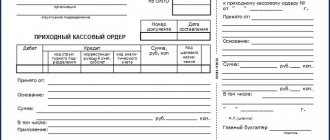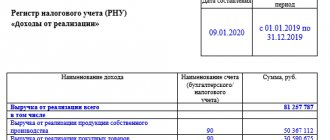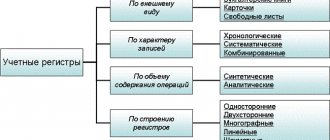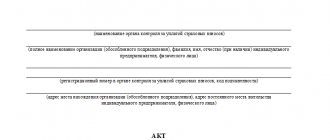General information about the materials accounting card
The form of the document was approved by Resolution of the State Statistics Committee of Russia dated October 30, 1997 No. 71a. A separate card is drawn up for each item number, and the financially responsible person is responsible for its maintenance. Entries in the card are made on the basis of primary documents.
Since 2013, maintaining this form is not mandatory. Organizations are given the right to develop their own forms, which must contain a list of details approved by law.
Form M-17 “Material Accounting Card” is also used to release materials to production from the warehouse in which they are stored. An appropriate entry about the movement is made in the document, certified by the signature of the responsible person.
Who fills out form 0504041
Based on Order of the Ministry of Finance dated May 30, 2015 No. 52n, the OKUD form 0504041 is mandatory for accounting departments of all government agencies, including:
- State-owned;
- Budget;
- Autonomous.
State or municipal unitary enterprises are required to fill out the card if they keep budgetary records of the facts of economic life that arise when they perform the functions of customers when concluding government contracts on behalf of government authorities. The order applies to extra-budgetary funds and two state corporations: Roscosmos and Rosatom, also in terms of maintaining budgetary accounting.
Card for quantitative and total accounting of material assets
How to fill out the M-17 card?
At the top of the document indicate the name of the organization and structural unit. Below is a table consisting of 16 columns:
- in the 1st column indicate detailed information about the structural unit in which inventory items are stored;
- in the 2nd - the type of activity carried out by the division;
- in the 3rd – warehouse number;
- in the 4th and 5th - a specific storage location for the material;
- in the following columns indicate the brand, grade, profile and size of the goods and materials, respectively;
- Next, you need to indicate the item number of the product, unit of measurement, price, stock rate, expiration date and the full name of the supplier.
If any information is missing, you can put a dash. After the table there is a field “Name of material”. The full name of the goods and materials is written here.
Next is another table. It is filled out if precious metals or stones are present in the inventory. The table contains the following information:
- name of the precious metal (stone);
- view;
- item number;
- unit of measurement;
- quantity (or mass);
- passport ID.
The third table contains information about the movement of materials:
- in the “Record date” column, enter the dates when the inventory was moved;
- in the “Document number” column indicate the number of the primary document that became the basis for the operation;
- in the column “Sequential number” indicate the serial number of the record;
- in the column “From whom it was received or to whom it was issued” the name of the organization or structural unit is written down;
- in the next column indicate the accounting unit of production;
- in the columns “Receipt”, “Expense” and “Balance”, indicate how many inventory items were received, issued and are available in the balance after the completion of each operation;
- in the last column put the signature of the responsible person and the date of the operation.
The last part of the card indicates the position of the financially responsible employee, his full name and the date of filling out the document (see a sample of filling out the card here).
Instructions for filling
The step-by-step algorithm for filling out a materials warehouse card consists of only five stages.
Step 1. Register the date and document number. We indicate the details in chronological order. We take into account the indicators of the previous document issued in the warehouse.
Step 2. We fix the name of the organization in which the accounting register is established. If necessary, indicate the structural unit. For example, enter “Warehouse No. 1” or “Food warehouse”.
Step 3. We begin to design the tabular part of the document. We step by step enter the following information:
- structural unit - in column No. 1;
- type of economic activity - in column No. 2;
- the number of the warehouse in which inventory items are stored is in column No. 3;
- specify the storage location in separate columns of the tabular part of the document, numbered 4 and 5.
Now you need to detail the information about the property received for storage. Write down the qualitative characteristics of inventory items. Write down the brand, profile, grade, size, cost and price. Data should be taken from the technical passport and other documentation that comes with the assets.
Step No. 4. A separate table in form M-17 reveals information about the presence of precious stones and metals in the accounting object. Register information in strict accordance with the passport documentation for inventory items. Approximate and inaccurate information is not allowed. If there is no information, put a dash in the plate. Or write “No data available.”
Step No. 5. The third table reveals information about the movements of inventory items within the enterprise. Display the information in the columns of the table:
- Indicate the date of actual movement of the goods in the “Date of Record” column.
- Register the number of the primary document (base document) confirming the movement of goods in column 1 Document number.”
- Enter the sequence number of the operation in the “Sequence number” column.
- We record the name of the structural unit or the name of the organization from which the inventory item was received, or to whom it was transferred - the column “From whom it was received or to whom it was issued.”
- Now we enter the unit of output of goods received or issued.
- The columns “Incoming”, “Expense” and “Balance” are filled in according to the nature of the transaction being recorded. When goods and materials are received, enter the information in the “Receipt” column. Upon disposal - in “Expense”. The remainder, that is, the total, is summed up after each operation.
Features of filling out the card
- All necessary invoices must be attached to the card.
- You can fill out the document either by hand or on a computer.
- There is no need to put a stamp on the card, since it relates to the internal document flow of the enterprise.
- No blots or inaccuracies are allowed in the document form. If a mistake was made, it is better to issue a new form. You can also carefully cross out false information and write the correct information above, confirming the correction with the signature of the person in charge.
- You cannot make notes with a pencil, only with a pen.
- Cards are issued for 1 year. At the end of the calendar year, balances from old cards are transferred to new ones (as of January 1). After the end of the reporting period, the completed cards are transferred to the accounting department, and then to the organization’s archive. Shelf life - at least 5 years.
Personal registration card issuance sample form
A personal issuance registration card involves registration of the issuance of personal protective equipment, which may be necessary due to the peculiarities of production technologies and the need to protect workers from the harmful influences of various factors.
Among such products, it is worth noting first of all the following list:
- Safety shoes, protective or special clothing,
- Gas masks, as well as earplugs,
- Mittens and face shields,
- Safety belts and much more.
It is worth noting that such products are of exceptional importance for users, because they help preserve personnel’s health and, sometimes, life, providing the necessary level of safety in production.
Personal issuance card and its purpose
A personal card for recording the issuance of such products is presented in the form of a reporting form, which contains quite detailed information about the employee, as well as information about exactly what funds have been issued or are being issued to him.
With the help of such papers, it is possible to keep under control the timing of the use of protective equipment, their quantity, and some other aspects of their operation.
All this becomes most important in hazardous industries, where the use of such means becomes the main aspect among other safety measures and protection of human lives.
Design rules
Personal cards of this kind are usually kept by storekeepers, and they must contain the following information - personnel numbers, full name, surname and patronymic of the employee, his structural unit.
The date the person started working and his position, size and size are also indicated for the correct selection of protective equipment, and in situations involving changes in the unit or list of personal protective equipment that must be used, it is necessary to indicate the date of the changes made, and in particular, the new position.
Within the framework of such a document, it is necessary to indicate exclusively personal protective equipment.
The form of such a form is standardized.
There are also collective cards issued to shift workers, but for them there is a separate Duty card. Personal cards must be filled out by the storekeeper, indicating all the necessary information.
All changes must also be made in a timely manner by him. And the fact of filling out this form must coincide in time with the employee’s assumption of a position that requires the use of protective equipment.
Card for recording material assets in the budget
The card for recording material assets (OKUD 0504043), used in the public sector, was approved by Order of the Ministry of Finance of the Russian Federation dated March 30, 2015 N 52n. It is intended for accounting of inventory items available in the warehouse. The form contains information about the type and location of inventory items, their price, and supplier.
This form is used in government agencies that have a small amount of material assets. The document may consist of several sheets, since each individual asset must be allocated a separate sheet. Entries in the document are made by the employee responsible for storing valuables. The card should be certified with the individual signature of the responsible person with a transcript. You can download the card form below.
Application of the order of the Ministry of Finance of Russia dated March 30, 2015 No. 52n
In accordance with paragraph 6 of Order No. 52n of the Ministry of Finance of Russia dated March 30, 2015, hereinafter referred to as Order No. 52n, this document is used when forming the accounting policy of an accounting entity, starting from 2015.
Paragraph 9 of Order No. 52n invalidated the order of the Ministry of Finance of Russia dated December 15, 2010 No. 173n “On approval of forms of primary accounting documents and accounting registers used by public authorities (state bodies), local governments, management bodies of state extra-budgetary funds, state academies sciences, state (municipal) institutions and Guidelines for their application”, hereinafter referred to as Order No. 173n.
The application of Order No. 52n is stated in the letter of the Ministry of Finance of Russia dated June 10, 2015 No. 02-07-07/33768:
“Order No. 52n was registered by the Ministry of Justice of Russia on June 2, 2015, the date of publication on the Official Internet Portal of Legal Information is June 8, 2015 (the effective date is June 19, 2015). Please note that, in accordance with paragraph 6 of Order No. 52n, its provisions are applied when forming the accounting policy of the subject of accounting, starting from 2015.
Taking into account the above, the application of new forms is carried out by the institution from the moment of approval of changes to the acts establishing the rules for its document flow and technology for processing accounting information for the purposes of organizing and maintaining accounting, adopted as part of the formation of its accounting policy for 2015, taking into account its organizational and technical readiness ."
Thus, when making changes to the accounting policy of an institution, it is necessary to take into account organizational and technical readiness. If an institution generates primary documents and accounting registers in a software product, it is clear that their formation using new forms is possible only after the program update is installed, in which the corresponding changes are implemented.
According to oral explanations from specialists from the Department of Budget Methodology of the Ministry of Finance of Russia, different application dates may be established for different forms in the accounting policies of an institution.
Important! When making changes to the accounting policy of an institution regarding the application of the forms established by Order of the Ministry of Finance of Russia dated March 30, 2015 No. 52n, we recommend taking into account the timing of the implementation of changes in the program “1C: Accounting of a State Institution 8” (see Table 1) and updating the working information base.
OS inventory cards
Inventory cards of fixed assets are accounting registers of the standard form OS-6, intended for object-by-object accounting of fixed assets. They are filled out for each object at the time of its receipt and the completion of the commissioning certificate. The number of the inventory card of fixed assets is assigned in accordance with the numbering of the warehouse card file.
We talked in detail about filling out OS inventory cards here.
An inventory of inventory cards for accounting of fixed assets must be continuously maintained. It is compiled for the purpose of registering opened cards and monitoring their safety. The inventory is compiled in the accounting department in one copy. When a note is made in the inventory about the write-off of objects according to the last inventory card, it is handed over to the archive.
Materials inventory book: form M-17
In addition to the M-17 card, to keep track of the movement of material assets, you can use the materials warehouse book (clause 54, clause 274 of the Order of the Ministry of Finance of the Russian Federation dated December 28, 2001 No. 119n).
In the warehouse accounting books, a separate personal account is opened for each item number, which contains the same details and is numbered in the same order as the material accounting cards. The sheets of the warehouse accounting book must be numbered, laced and certified by the signature of the chief accountant (or a person authorized by him) and a seal, if available (clause 274 of the Order of the Ministry of Finance of the Russian Federation dated December 28, 2001 No. 119n).







